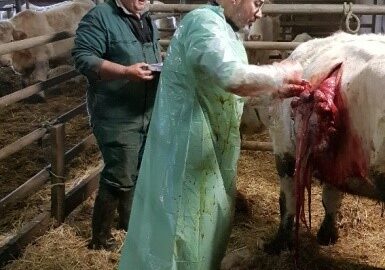Brucellose des ruminants : les foyers bovins de 2012 en France et en Belgique appellent à la vigilance

Auteurs
Résumé
Deux foyers de brucellose bovine ont été confirmés en 2012 sur le territoire français, alors qu’aucun cas n’avait été rapporté depuis 10 ans. Le premier foyer (Nord-Pas-de-Calais), dans lequel Brucella abortus biovar 3 (bv.3) a été mise en évidence, avait pour origine l’introduction d’un bovin issu d’un foyer confirmé en Belgique. La propagation de la maladie en France est restée très limitée car l’introduction était récente et les acteurs du système de surveillance ont été réactifs. En revanche, en Belgique, 5 foyers à B. abortus bv. 3 ont été mis en évidence sans que l’origine n’ait pu être identifiée. Le second foyer français a été confirmé dans une exploitation laitière de Haute-Savoie, à la suite d’un diagnostic établi après un avortement. Ce foyer, dû à Brucella melitensis bv.3, a été responsable d’une contamination humaine par consommation de fromage frais produit dans cette ferme. L’origine de cette résurgence reste à déterminer. Ces cas soulignent l’importance du maintien du dispositif de surveillance et montrent que la vigilance, notamment la surveillance des avortements, constitue un véritable enjeu en situation assainie.
Abstract
Two outbreaks of bovine brucellosis were confirmed in 2012 in France, while no cases had been reported over the previously 10 years. The first outbreak (Nord-Pas-de-Calais) due to Brucella abortus biovar 3 (bv.3), was caused by the introduction of a cow from an infected Belgian herd. The impact of the disease remained limited in France due to the recent nature of its introduction and the responsiveness of the surveillance team. In contrast, in Belgium 5 outbreaks due to B. abortus bv. 3 were confirmed although the origin has not been identified. The second French outbreak, due to B. melitensis bv. 3, was confirmed in a dairy farm located in Haute-Savoie after an abortion. Human contamination occurred through the consumption of cheese made from fresh raw-milk produced in the farm. The origin of this case remains unidentified. These recent cases highlight the importance of maintaining surveillance and show that vigilance, namely abortion monitoring, is a key issue even when overall herd health is good.
D'autres articles
Découvrez aussi nos formations
05 janvier 2026
5 jours
Bovin laitier · Bovin viande · Bovins

